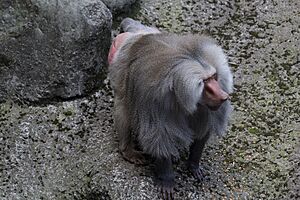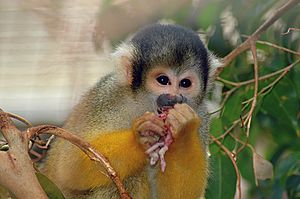Haplorhini facts for kids
Quick facts for kids Haplorhines |
|
|---|---|
 |
|
| Hamadryas baboon (Papio hamadryas) | |
| Scientific classification |
|
| Kingdom: | Animalia |
| Phylum: | Chordata |
| Class: | Mammalia |
| Order: | Primates |
| Suborder: | Haplorhini Pocock, 1918 |
| Infraorders | |
|
|
| Synonyms | |
|
Simia |
|
Haplorhines are a special group of primates. They are also called "dry-nosed" primates. This name comes from the Greek words for "simple-nosed." This group includes tarsiers, monkeys, and apes. Humans are also part of the haplorhine group.
Haplorhines are different from another group of primates called strepsirrhines. Strepsirrhines are known as "wet-nosed" primates. Scientists believe haplorhines and strepsirrhines started to become separate groups about 63 million years ago.
Contents
What Makes Haplorhines Special?
Haplorhines have several unique features that set them apart.
Nose and Face
Unlike strepsirrhines, haplorhines do not have a wet nose pad (called a rhinarium). Their upper lip is not connected directly to their nose or gums. This allows them to make many different facial expressions. Think about how many different faces humans can make!
Brain and Senses
Haplorhines have a much larger brain compared to their body size than strepsirrhines. Their main sense is vision. They have a special bone structure around their eyes called a postorbital plate. This protects their eyes better than the postorbital bar found in strepsirrhines. Most haplorhines are active during the day (diurnal). The only exceptions are tarsiers and night monkeys, which are active at night.
Other Body Features
Haplorhines, including tarsiers, cannot make their own Vitamin C. Most other mammals, including strepsirrhines, can make this vitamin. This means haplorhines need to get Vitamin C from their food.
Reproduction and Babies
Most haplorhines have a single-chambered uterus. Tarsiers are an exception, having a uterus with two horns, similar to strepsirrhines. Most species usually have one baby at a time. However, marmosets and tamarins often have twins or triplets.
Haplorhine babies are born relatively large compared to strepsirrhine babies. They also depend on their mothers for a longer time. This longer period of care helps them learn complex behaviors.
Where Does the Name "Haplorhini" Come From?
The scientific name Haplorhini comes from two Ancient Greek words. Haploûs means "onefold," "single," or "simple." Rhinos means "nose." So, Haplorhini means "simple nose." This refers to the fact that they don't have the wet nose pad (rhinarium) that many other mammals, including strepsirrhine primates, have.
How Haplorhines Evolved

Scientists use genetic information to estimate when different animal groups separated. Based on their genes, haplorhines and strepsirrhines likely separated about 74 million years ago. However, the oldest known fossils of modern primates are from about 56 million years ago.
The tarsiers are a very old group within haplorhines. Genetic studies suggest they branched off from other haplorhines about 70 million years ago. An ancient fossil primate called Archicebus might be similar to the very first common ancestor of tarsiers and other haplorhines.
Monkeys and Apes
The other main group within haplorhines is the simians, also known as anthropoids. This group includes all monkeys and apes. Simians are divided into two main types:
- Platyrrhini: These are the New World monkeys, found in Central and South America. They split from the catarrhines about 35 to 40 million years ago.
- Catarrhini: These are the Old World monkeys and apes, found in Africa and Asia.
Apes (Hominoidea) separated from Old World monkeys (Cercopithecoidea) about 25 million years ago. Fossils show that both apes and Old World monkeys first appeared in Africa.
Haplorhine Family Tree
Here is a simplified list of the living haplorhine families:
- Order Primates
- Suborder Strepsirrhini: lemurs, lorises, galagos, etc.
- Suborder Haplorhini: tarsiers, monkeys, and apes
- Infraorder Tarsiiformes
- Family Tarsiidae: tarsiers
- Infraorder Simiiformes: monkeys and apes
- Parvorder Platyrrhini: New World monkeys
- Infraorder Tarsiiformes
* Family Callitrichidae: marmosets, tamarins * Family Cebidae: capuchins, squirrel monkeys * Family Aotidae: night or owl monkeys * Family Pitheciidae: titis, sakis, uakaris * Family Atelidae: howler, spider, and woolly monkeys
-
-
-
- Parvorder Catarrhini Old World anthropoids
-
-
* Superfamily Cercopithecoidea ** Family Cercopithecidae: Old World monkeys * Superfamily Hominoidea: apes ** Family Hylobatidae: lesser apes (gibbons) ** Family Hominidae: great apes
See also
 In Spanish: Haplorrhini para niños
In Spanish: Haplorrhini para niños

